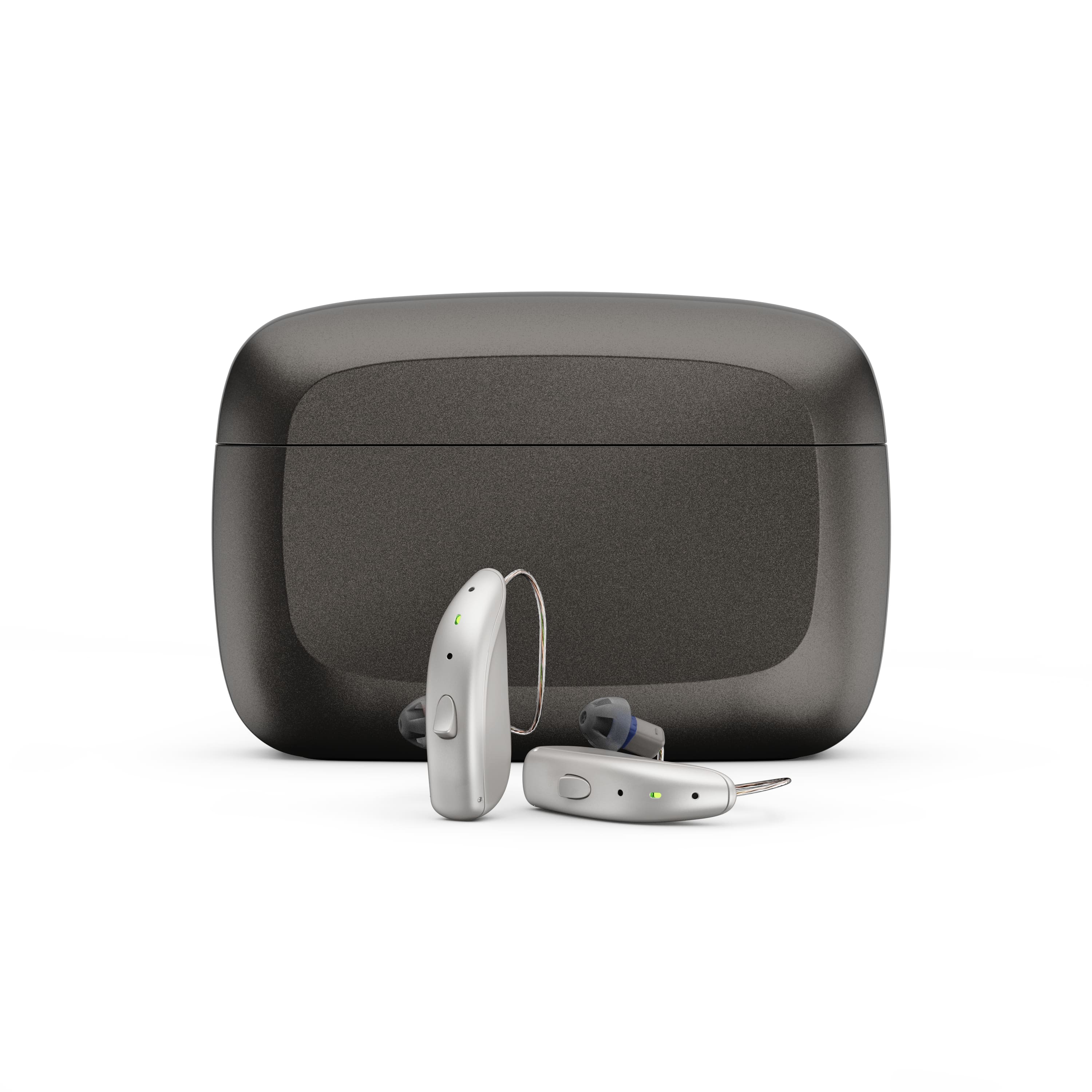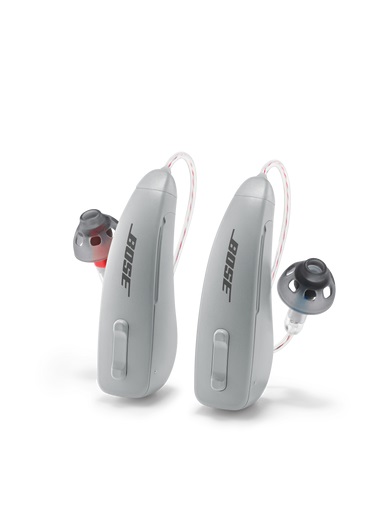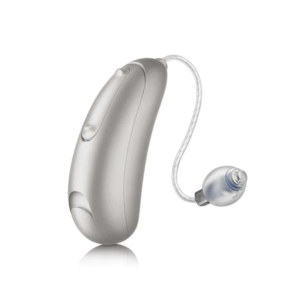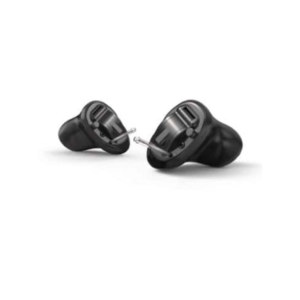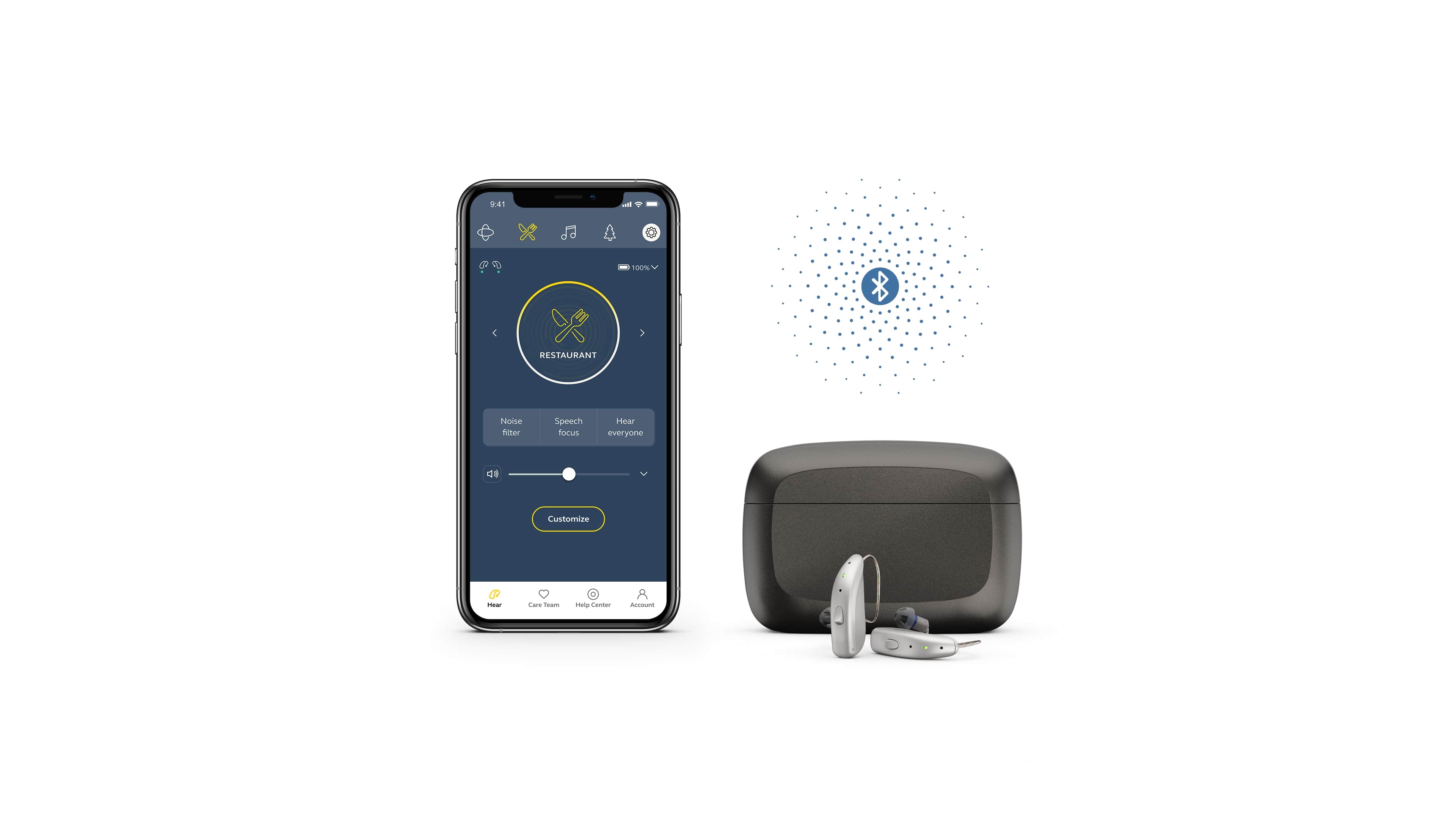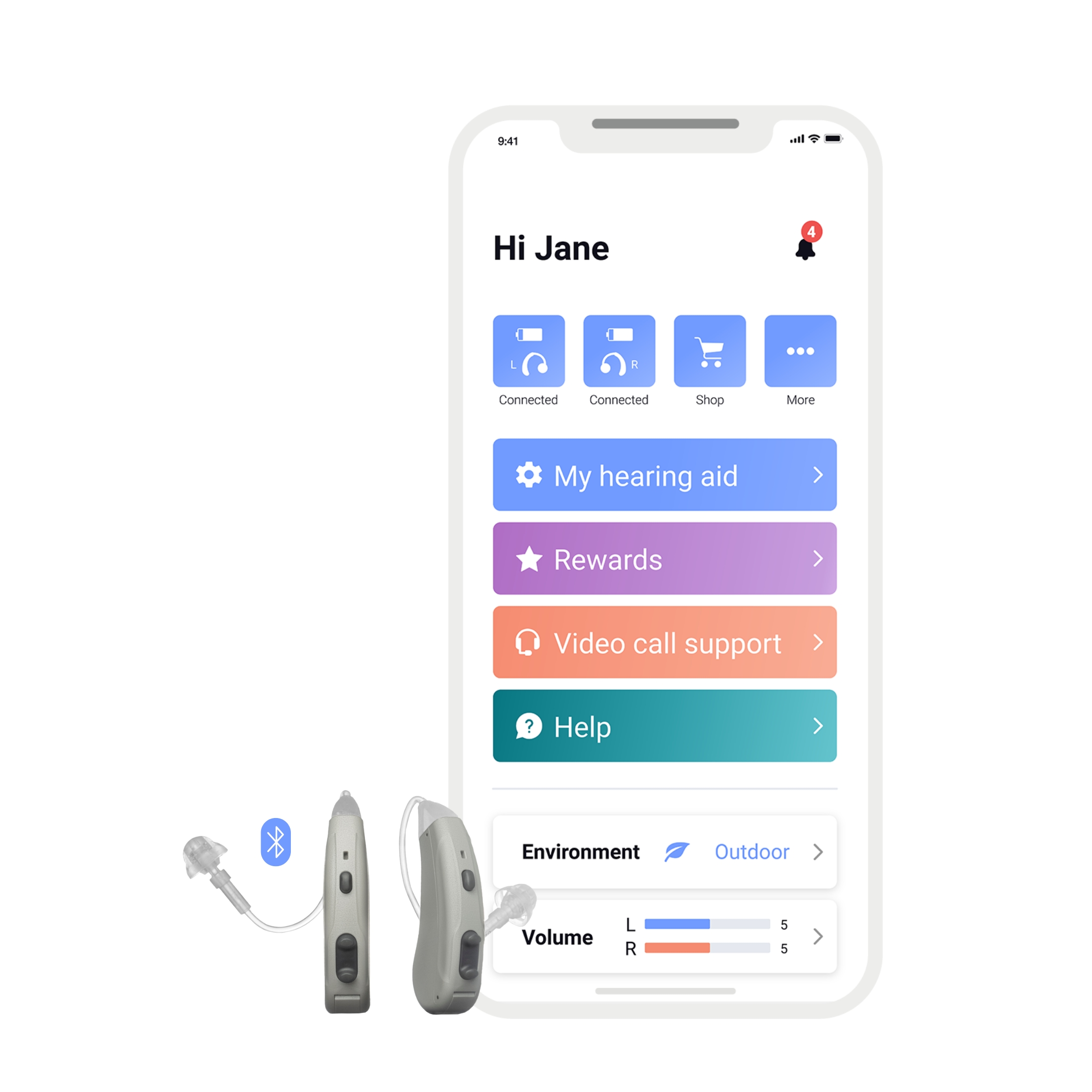Best Hearing Aids for iPhone
Hearing aid technology has advanced significantly over the last decade, and Bluetooth functionality now allows users to connect their smartphones directly to their hearing aids—providing direct streaming, volume control, and remote programming.
According to Statista, there are an estimated 120 million active iPhone users in the United States, so it’s no surprise Apple entered the hearing aid space with its Made for iPhone (MFi) program in 2014.
Since then, numerous MFi hearing aids have entered the market. With MFi hearing aids, users can unlock convenient Bluetooth streaming and basic controls directly on the iPhone’s accessibility settings without using an app. “Essentially, all major hearing aid manufacturers offer some form of MFi and Bluetooth compatibility,” said Trisha Muth, Au.D., an audiologist from Bay Area Audiology in Maryland.
Many of the best hearing aids prioritize MFi functionality or easy-to-use Apple store applications to accommodate millions of iPhone users.
Best Hearing Aids for iPhone
- Editor’s Pick: Jabra Select 200
- Most Affordable: Lexie B2
- Best Over-the-Counter Option: Audicus Omni
- Best Tech Features: Starkey Evolv AI
- Best Sound Quality: Widex MOMENT
- Best for Severe Hearing Loss: Oticon Own
How We Made Our Picks
Our experts research and recommend products that can help give you a better quality of life. Using our high standards and rigorous testing methodology, we’ve spent more than 5,000 hours, collectively, researching hearing aids to help you find the best device for you. Throughout our research process, we did the following:
- Consulted with audiologists and geriatric care experts
- Mystery shopped the brands
- Surveyed hundreds of hearing aid users
- Tested various models of hearing aids
- Interviewed experts in the field
- Read thousands of verified customer reviews
- Engaged in ongoing independent research
To create our list of the best hearing aids for iPhone, we determined our top picks based on the following criteria:
- Price
- Audiologist care
- Warranty
- Customer service
- Bluetooth connectivity
- Comfort and fit
- Reliability
See our full Hearing Aids Ratings Methodology.

What Are Made for iPhone (MFi) Hearing Aids?
MFi hearing aids are made to connect specifically to iPhones, iPads, iPods, and Apple Watches using Bluetooth. iPhones that can use this feature need to be iOS 7 and iPhone 4S or later. Because they are Apple-specific, they don’t connect directly to other electronics—like Android devices—without an app or an intermediary streaming device.
How Do Intermediary Streaming Devices Work?
Intermediary streaming devices, or streamers, are Bluetooth devices that pick up audio from a phone and send it to your hearing aids. They serve as the bridge between the audio source and your ear.
Streamers were once the only solution to bridge external devices to hearing aids, but they are quickly becoming an outdated accessory as more Bluetooth hearing aids have streaming functionality built into them. You can find them for older iPhone and Androids on various hearing aid brand websites like Jabra Enhance.
MFi hearing aids have many advantages that other non-MFi devices can’t access. They allow you to:
- Connect, stream, and control audio directly from your iPhone and other Apple products.
- Place volume controls on your lock screen for easy access.
- Customize different environment presets in your iPhone settings.
Some MFi hearing aids have additional features that allow you to:
- Seamlessly switch audio from one Apple device to another without pairing.
- Connect your hearing aids to your iPhone’s GPS through the “Find My Hearing Aids” function, which allows you to locate them if you misplace them.
The most unique feature that MFi hearing aids provide is the ability to use Live Listen through the iPhone. Live Listen allows you to use your phone as a microphone to stream surrounding sound directly into your hearing aids. For example, if you place your iPhone in the middle of the dining room table or a conference room meeting, you’ll be able to hear the voices that the iPhone picks up.
You can find out if your hearing aids are MFi by checking the model’s website page or brochure for these icons:

MFi hearing aids have app compatibility with Android, but you won’t necessarily be able to directly stream music or calls from your smartphone. According to the Jabra Enhance website, the brand’s Select hearing aid models are not fully compatible with Android OS version 12, with reported connectivity issues and inability to use app features. Android users will also miss out on the Live Listen function, so you may need to purchase a separate accessory like Phonak’s Roger microphone if you have Phonak hearing aids and want the same function.
MFi Hearing Aids vs. Bluetooth Hearing Aids
All MFi hearing aids use Bluetooth to connect, but not all Bluetooth hearing aids have MFi function. Bluetooth hearing aids without MFi function are still compatible with iPhones and use the brand’s remote app to control settings instead. They also may have a Bluetooth streaming function. Since MFi hearing aids are typically priced above $1,000, this isn’t a bad trade-off for those looking for affordable and simple options.
Hearing Aids With Bluetooth Streaming vs. Bluetooth Connectivity
Most Bluetooth hearing aids connect to phones directly or through an app. This does not mean that those Bluetooth hearing aids offer streaming. Bluetooth streaming allows you to use your hearing aids like a wireless headset to accept calls or listen to music. All MFi hearing aids offer streaming from the iPhone to your hearing aids.
Most completely-in-canal (CIC) or invisible-in-the-canal (IIC) styles cannot perform Bluetooth streaming functions because they are too small to fit the technology, with Starkey Evolv AI being the exception.
Hearing aids with Bluetooth connectivity that can’t stream might have a telecoil instead, which can capture sound in venues that have a telecoil hearing loop system. This allows you to tune in to concerts and theaters with less effort, but this feature is limited to places that have a loop system in place. All iPhone models 6 Plus and later have “telecoil mode,” which reduces interference from cell phone radio transmitters to enhance sound during calls, but you need a hearing aid with telecoil for this to work. Otherwise, you’ll need a streamer to send audio from your phone to the hearing aids with clear quality.
Comparisons of the Top Hearing Aids for iPhone
| Model |
| Jabra Select 200 | |
| Superlatives | Editor’s Choice |
|---|---|
| Price | $1,995 per pair |
| MFi | |
| Bluetooth Streaming | |
| Battery Type | Recharge |
| Battery Life | 30 hours |
| Lexie B2 | |
| Superlatives | Most Affordable |
|---|---|
| Price | $999 or $49/month for a subscription |
| MFi | |
| Bluetooth Streaming | only connectivity to app |
| Battery Type | Recharge |
| Battery Life | 18 hours |
| Audicus Omni | |
| Superlatives | Best OTC Option |
|---|---|
| Price | $2,998–$3,398 per pair or $159/month with membership plan |
| MFi | |
| Bluetooth Streaming | |
| Battery Type | Recharge or disposable |
| Battery Life | 16 hours |
| Starkey Evolv AI | |
| Superlatives | Best Tech Features |
|---|---|
| Price | $2,800–$7,500 per pair |
| MFi | |
| Bluetooth Streaming | |
| Battery Type | Recharge or disposable |
| Battery Life | 24 hours |
| Widex MOMENT | |
| Superlatives | Best Sound Quality |
|---|---|
| Price | $2,800–$7,500 per pair |
| MFi | |
| Bluetooth Streaming | |
| Battery Type | Recharge or disposable |
| Battery Life | 37 hours |
| Oticon Own | |
| Superlatives | Best for Severe Hearing Loss |
|---|---|
| Price | $2,598–$7,500 per pai |
| MFi | |
| Bluetooth Streaming | |
| Battery Type | Disposable |
| Battery Life | 2–7 days |
Best Hearing Aids for iPhone in Detail
- Cost: $1,995 per pair
- Types of Hearing Loss: Mild to moderate
- How to Purchase: Online
- Hearing Aid Style: Receiver-in-canal (RIC)
- Features: MFi, Bluetooth streaming, tinnitus management, rechargeable battery
Pros
-
Easy-access volume controls in iPhone settings or lock screen
-
Live Listen functionality for group settings
-
100-day trial period
-
Three-year manufacturer warranty
Cons
-
Removing the domes requires a lot of force, making cleaning difficult
-
Connecting app to hearing aids is inconsistent, limiting access to advanced settings and remote customer service
-
Only available in the receiver-in-canal style
- Cost: $999 per pair, or subscribe with a one-time fee of $249 per pair followed by monthly payments of $49 for 24 months
- Types of Hearing Loss: Mild to moderate
- How to Purchase: Online or at select retail stores
- Hearing Aid Style: Behind-the-ear (BTE)
- Features: Bluetooth connectivity, rechargeable batteries, one-year manufacturer warranty, 45-day trial period
Pros
-
Subscription option available for low monthly payments
-
Easy-to-use iPhone app
-
Rechargeable battery
-
Great reviews about customer service
Cons
-
No Bluetooth streaming
-
No telecoil
- Cost: $2,998 per pair, or subscribe for a one-time fee of $499 per pair followed by $159 monthly payments for 18 months
- Types of Hearing Loss: Mild to moderate
- How to Purchase: Online
- Hearing Aid Style: Receiver-in-canal (RIC)
- Features: Bluetooth streaming, telecoil by request, tinnitus management, rechargeable or disposable battery, 45-day trial period, two-year manufacturer warranty
Pros
-
Bluetooth streaming
-
Audicus Plus membership program offers a monthly payment plan
Cons
-
Short 16-hour battery life
-
Customer support not easily accessible through the app
-
Unclear if you can purchase through clinics
- Cost: $2,800–$7,500 per pair depending on the specific model
- Types of Hearing Loss: Mild to profound
- How to Purchase: Prescription through an audiologist
- Hearing Aid Styles: Invisible-in-canal (IIC), completely-in-canal (CIC), in-the-canal (ITC), in-the-ear (ITE), receiver-in-canal (RIC), behind-the-ear (BTE)
- Features: MFi, Bluetooth streaming, rechargeable or disposable battery, telecoil, 30-day trial period, one to three-year manufacturer warranty
Pros
-
Easy-access volume controls in iPhone settings or lock screen
-
Live Listen functionality for group settings
-
Only CIC on the market that is MFi and streams Bluetooth
-
Available in a wide range of styles
Cons
-
High price point
-
Only 30-day trial period
-
Inconsistent Bluetooth connection
- Cost: $2,800–$7,500 per pair depending on the specific model
- Types of Hearing Loss: Mild to profound
- How to Purchase: Prescription through an audiologist
- Hearing Aid Styles: Behind-the-ear (BTE), receiver-in-canal (RIC), and in-the-ear (ITE)
- Features: MFi, Bluetooth streaming, rechargeable battery, telecoil mode on the app, tinnitus management, 45-day trial, three-year manufacturer warranty
Pros
-
Easy-access volume controls in iPhone settings or lock screen
-
Live Listen functionality to listen well in group settings
-
Longest battery life at 37 hours
-
Offers PureSound technology to process sound quickly and comfortably
-
Uses MySound artificial intelligence (AI) to customize your hearing experience
Cons
-
Prescription only
-
Pricy
-
Poor customer service
- Cost: $2,598–$7,500 per pair depending on the specific model
- Types of Hearing Loss: Mild to severe
- How to Purchase: Prescription through an audiologist
- Hearing Aid Styles: Invisible-in-canal (IIC), completely-in-canal (CIC), in-the-canal (ITC), in-the-ear half-shell (ITE HS), in-the-ear full-shell (ITE FS)
- Features: MFi, Bluetooth streaming, disposable battery, telecoil in some styles, trial period and warranty dependent on retailer
Pros
-
Easy-access volume controls in iPhone settings or lock screen
-
Live Listen functionality to listen well in group settings
-
Deep Neural Network (DNN) technology to drastically reduce hearing effort
-
Addresses wide range of hearing loss
Cons
-
Only available in ITE styles
-
Disposable battery only
How Much Do iPhone-Compatible Hearing Aids Cost?
The best hearing aids that we’ve selected range from $999–$7,500 per pair. The price range is wide because there are many different customizations and technologies available from various manufacturers and brands.
MFi hearing aids are the most expensive picks, ranging from $1,995–$7,500 per pair. They’re expensive for a good reason. MFi hearing aids tend to have the most advanced technology with the convenience of all-in-one controls on the iPhone.
Hearing aids that are compatible with iPhone but are not MFi tend to be priced lower. For example, Lexie B2 made our list because it’s affordable, user-friendly, and accessible as an over-the-counter brand. However, you will have to sacrifice streaming and direct iPhone controls and rely more on the brand’s app for hearing aid settings.
Once you start adding on features like Bluetooth streaming, your price begins to increase. The Audicus Omni is a great example of a non-MFi hearing aid that has Bluetooth streaming and hands-free calling but is priced much higher at $2,998 per pair.
How to Pair Hearing Aids to an iPhone
Hearing aids with Bluetooth connectivity can pair with an iPhone in settings:
- Go to Settings > Bluetooth and toggle Bluetooth settings “on” so that the switch is green.
- Prepare your hearing aid for pairing according to the device-specific instructions found in the user manual. You may be required to restart your hearing aids or hold down a pairing button.
- Look for your hearing aids to appear under “Other Devices.”
- Select your hearing aids and wait for them to sync. Once synced, your hearing aids will appear under “My Devices.”

All MFi-specific hearing aids will be able to connect directly to the iPhone in “Hearing Device” settings. Once you’re paired, you’ll also be able to turn Live Listen on and off in these settings.
Here’s how Rachel Magann Faivre, Au.D., an audiologist and owner of Oklahoma City-based ASH Audiology, tells her patients to pair hearing aids:
- Make sure your phone’s software is up to date.
- Place a new battery in your hearing aid or make sure they’re sufficiently charged.
- Make sure your Bluetooth is on. Go to Settings > Connections > Bluetooth.
- Go to Settings > Accessibility > MFi Devices. Your phone will search for your hearing aids. If it doesn’t find them, open and shut your battery doors or place your hearing aids on their charger and then remove them.
- Once they are found, tap to connect the hearing aids by tapping the pair button once for each hearing aid.
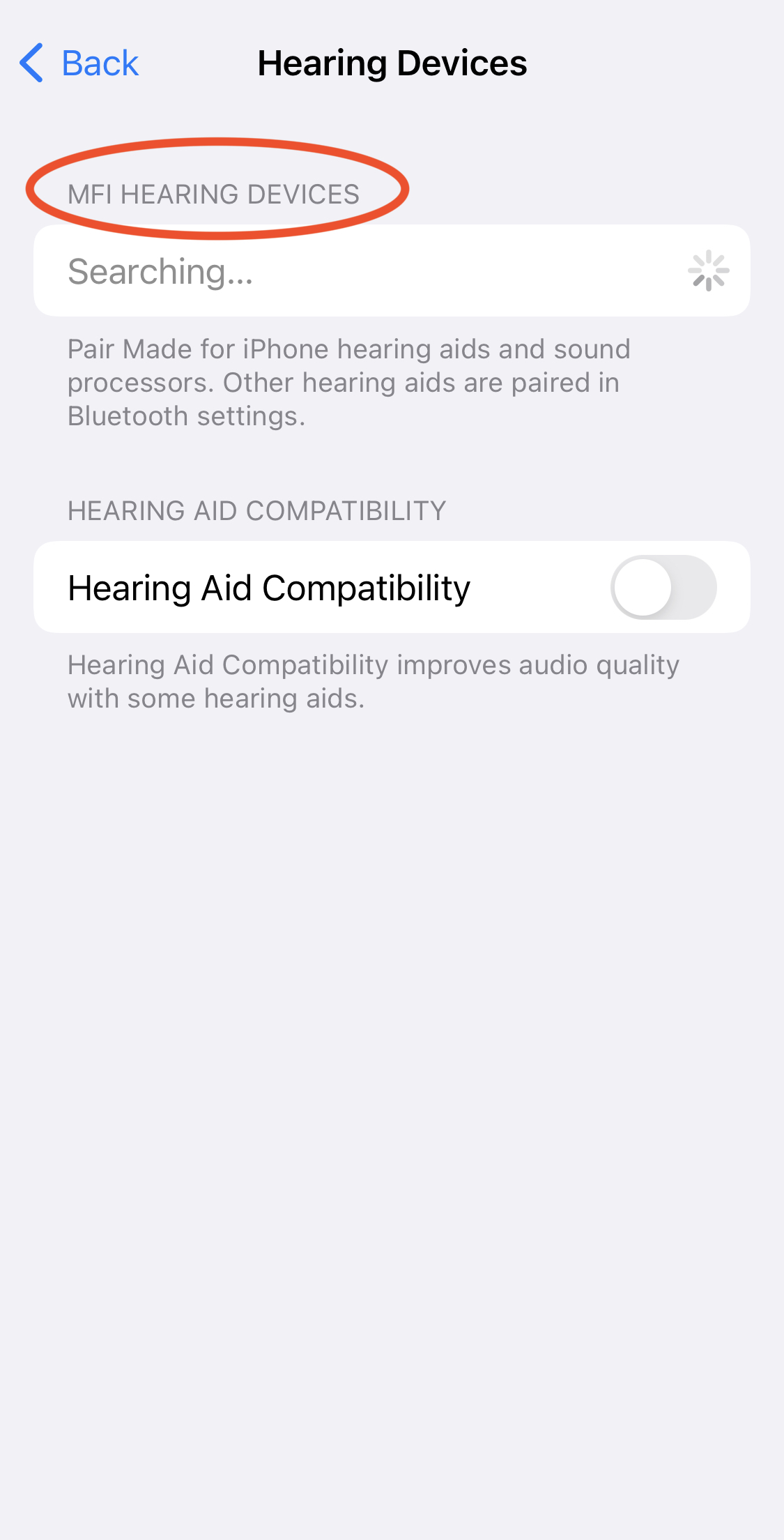
Pairing hearing aids can take at least 60 seconds. Jabra Enhance Select 200, Widex MOMENT, Audicus Omni, and Starkey Evolv AI all paired on the first try. Also, be sure to connect both hearing aids.
If you want to add another Apple device like your iPad, make sure all devices are on the same Wi-Fi network and signed into the iCloud under the same account. Then you can pair each device following the instructions above. Your audio should switch between devices automatically when you stream.
All Bluetooth hearing aids that connect to an iPhone’s Bluetooth can activate phone call compatibility in iPhone settings. This feature can help improve the audio quality by removing cell phone interference.
- For iPhone iOS 13 or later, go to Settings > Accessibility > Hearing Devices and turn on “Hearing Aid Compatibility.”
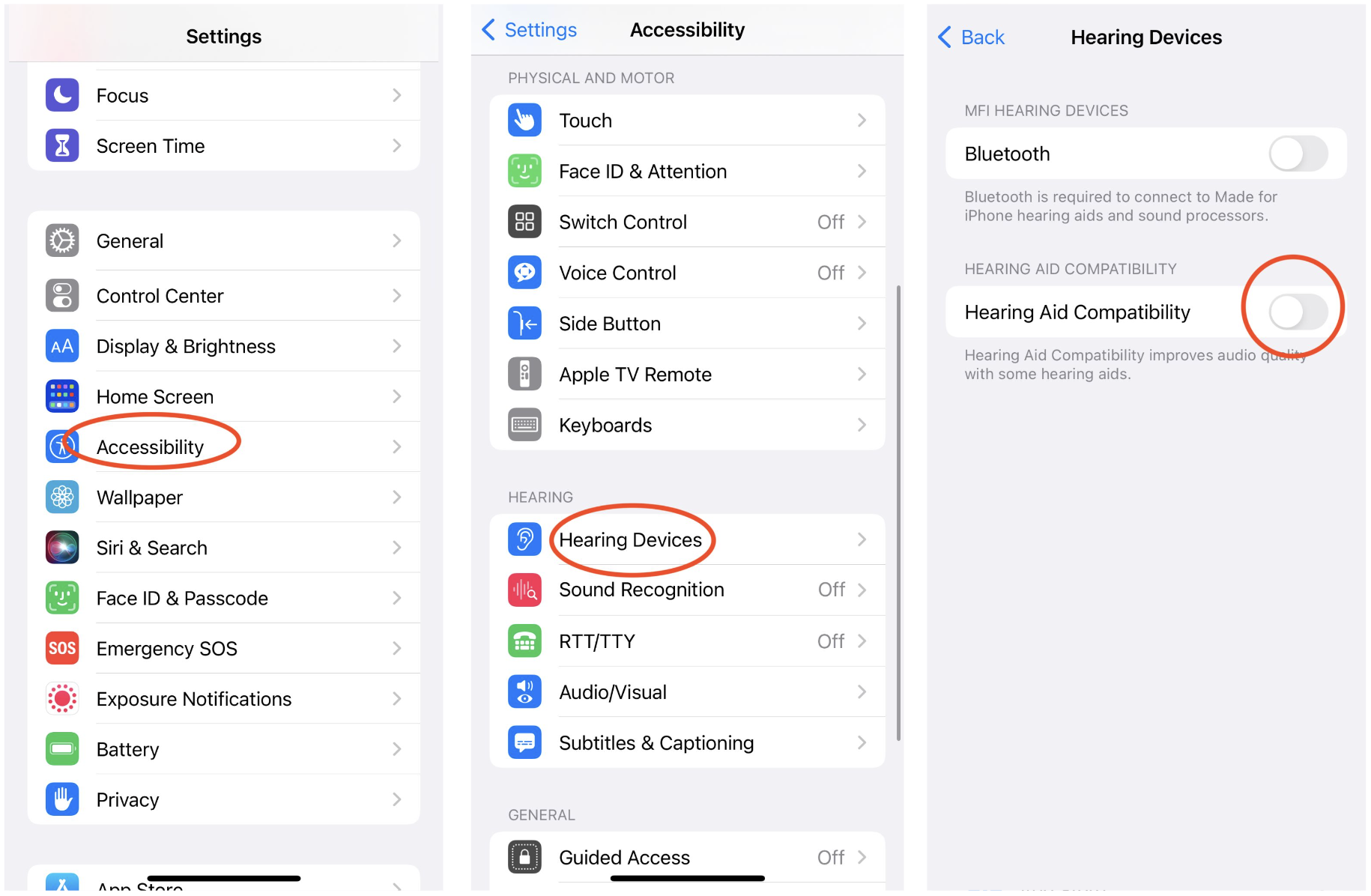
- For iPhone 6 or earlier, go to Settings > General > Accessibility and activate “Hearing Aid Mode.”
Most hearing aids with Bluetooth connectivity on the market correlate to a specific app that comes with unique features such as tinnitus relief and customer support. To get the app for your hearing aid:
- Go to the App Store > Search for your app’s name in the search bar > Download the app to your phone.
- Open the app and customize settings as prompted.
During our in-house testing, we found that the apps generally detected the hearing aids automatically. Hearing aid adjustments were easy to do once the app connected to them.
If you need to unpair your hearing aids from your iPhone, you can easily do so by going to Hearing Devices or Bluetooth settings and selecting “Forget Device.” We found that all our tested hearing aids could do this without any issue.
Why Won’t My Hearing Aids Pair With My iPhone?
If you’re having trouble pairing your hearing aids with your iPhone, you should first check to see if the phone is compatible. iPhones that are older than iPhone 4S models and have iOS 6 or earlier are not compatible. Next, check if your hearing aids are compatible. Hearing aids must have Bluetooth connectivity to pair to your iPhone.
Once you’ve checked that both your phone and hearing aids are both compatible with each other, you’ll need to troubleshoot.
- Go through the steps once more. Make sure that you have the Bluetooth setting on and you’ve opened and closed the hearing aids as instructed.
- Check your batteries. Make sure your rechargeable hearing aids are fully charged, or your disposable hearing aids aren’t dead.
- Restart your phone. Unfortunately, Bluetooth can be finicky. It doesn’t always connect smoothly, and sometimes it even loses connection once it’s made. You can reset it by restarting your phone.
- Delete the app and download it again. If your hearing aids aren’t connecting to the app on iPhone, you may need to reset the app by deleting it and downloading it again. If that doesn’t work, try “forgetting” the hearing aids in settings and pair them again to see if the app will detect them as they reconnect.
- Make sure you’re streaming through the right device. This isn’t a pairing issue but it can be perceived as a connectivity issue. Sometimes hearing aids are paired, but the audio streaming isn’t coming through. If your hearing aids are connected to multiple devices, make sure the audio is switched over to the one you intend to listen to. You can check if this feature is on by going to Settings > Accessibility > Hearing Devices and look for the Audio Handoff button. Otherwise, you can manually switch the device in the same settings or you can turn off the unwanted device.
- Make sure your hearing aids are clean. Hearing aids that haven’t been cleaned properly can build up dust, dirt, and excessive moisture. This can affect their functionality and can even damage electronic components. If you suspect that your hearing aids could be damaged, take them to your audiologist for a professional cleaning or ship them to the manufacturer for a factory repair. Depending on the age of your hearing aids, it might be worth buying new hearing aids instead of repairing your old, damaged ones.
If you’re still not sure why your hearing aids won’t connect to your iPhone, ask your audiologist, speak to your vendor, or reach out to the brand. They may be able to help.
Pros and Cons of Made for iPhone Hearing Aids
MFi hearing aids are a major tech advancement that improves user convenience and the hearing experience. There are some drawbacks, though.
Pros
All-in-one technology: The MFi concept condenses multiple accessory functions into one device. Hearing aids used to rely on external streamers and microphones for an optimal hearing experience, but now your iPhone provides both when paired to MFi hearing aids.
Controls in one place: You can control volume, check battery life, and change programs in your iPhone’s settings. You can even turn on the Live Listen feature here too. Everything you need to control is in one place. If you want more convenience, go to Settings > Accessibility > Hearing Devices and turn on “Control Lock Screen” to place some hearing aid controls on your lock screen.
Your hearing aids use GPS: Who knew hearing aids and GPS make the perfect pair? If you lose a pair of MFi hearing aids, you can find them using your iPhone. You can also use the geotagging function to assign certain environmental controls to specific locations like your home, the gym, or the park.
Cons
MFi is rarely found in smaller hearing aids. The only CIC-style hearing aid available that boasts MFi features is the Starkey Evolve AI 2400. Bluetooth streaming requires an antenna, and most hearing aids need larger styles to accommodate it. Starkey makes it work by using the removal string as the antenna, but others have yet to innovate this way.
Less battery life. All MFi hearing aids tested had rechargeable batteries that lasted one to three days. However, Bluetooth streaming drains them quickly. For example, the Widex MOMENT can last up to 37 hours, but it only lasts 24 hours if you use eight hours for streaming. You’ll need to charge your hearing aids at least every other day if you plan to use streaming often. This can be inconvenient if you’re used to a disposable battery’s seven-day life in simpler hearing aids.
The learning curve. Although Dr. Muth is generally in favor of MFi hearing aids, there are learning curves with the technology, she noted. “MFi hearing aids allow the user to have a lot of control, and sometimes patients don’t understand the adjustments they are making. It’s also important for users to be aware of software updates. Both hearing aids and Apple products will release periodic updates that can impact the connectivity between the two products. Hearing aid software updates are typically completed by your audiologist/hearing care professional in the office.”
“Typically we see connectivity issues after Apple releases an iPhone update,” said Dr. Magann Faivre. “The [hearing aid] apps need time to update, so I tell patients to wait on updating their iPhone until one to two weeks after the update is available. Usually by this time, the [hearing aid] apps have been updated too.”
Bottom Line
If you’re looking for hearing aids compatible with the iPhone, you have many options. Made for iPhone hearing aids have an array of functionality and convenience—but at a price. More affordable hearing aids like the Lexie B2 lose Bluetooth streaming capabilities but can still connect to the iPhone with an app.
Unfortunately, if you like more discreet styles, the technology just isn’t there yet. “The issue with connectivity has to do with the size of the device,” said Murray. Starkey Evolv AI’s CIC is the smallest style you’ll find with Bluetooth streaming.
Explore your options and take advantage of some of the longer trials and warranties, like the Jabra Enhance Select 200 hearing aid. It’s our favorite all-in-one pick, and you can even purchase it over-the-counter on the Jabra Enhance website.
While it’s enticing to purchase the newest technology of hearing aid, Dr. Muth emphasized that properly fitted hearing aids that meet your hearing loss needs are bottom line: “It is important that hearing aids are fit using best practices and Real Ear measurements are taken which verify that the hearing aids are programmed to the user’s prescription for their hearing loss. When best practices are adhered to, hearing aids are self adjusting so the need to change the volume/programming should be minimal.”
Frequently Asked Questions
-
Most hearing aids with Bluetooth connectivity can connect to an iPhone. However, not all Bluetooth hearing aids are Made for iPhone. There are only certain hearing aids that can connect directly to the iPhone, allowing you to access hearing aid controls and the Live Listen feature directly through iPhone settings.
WRITTEN BY
Nicole Hernandez is passionate about empowering people to live their lives to the fullest. She is a licensed DPT (doctor of physical therapy) in Nevada and received her degree from Campbell University in North Carolina. Nicole has used her degree to treat patients, produce research, and publish online pieces regarding health and rehabilitation. Now, her primary focus is to produce evidence-based content for AgingInPlace.org to ensure people receive the most factual information available as they make important decisions regarding their wellness journey.
MEDICALLY REVIEWED BY
Dr. Magann Faivre is an audiologist with a passion for being active in audiology organizations, particularly concerning advocacy, patients’ rights issues, and teaching student leadership. She intimately grew up around hearing loss and empathizes with patients when discussing their hearing journey. She is dedicated to creating a positive and integrative hearing healthcare experience so patients leave informed and confident. Dr. Magann Faivre currently serves on The Audiology Project’s Board of Directors and on Northern Illinois University’s Advisory Board. She is a longstanding fellow of the American Academy of Audiology and Academy of Doctors of Audiology.

